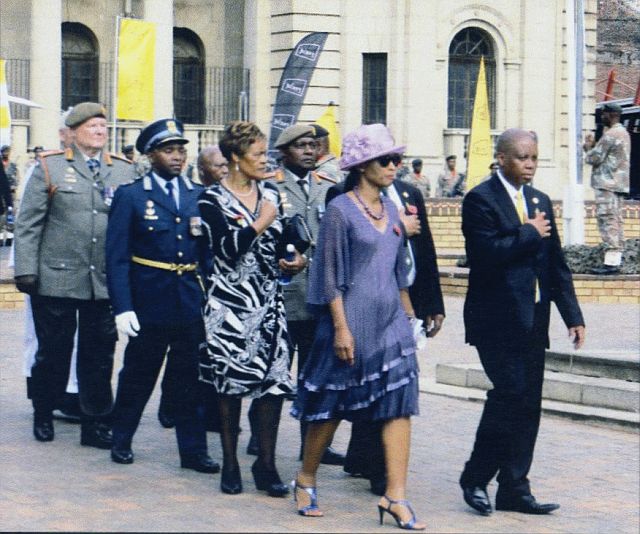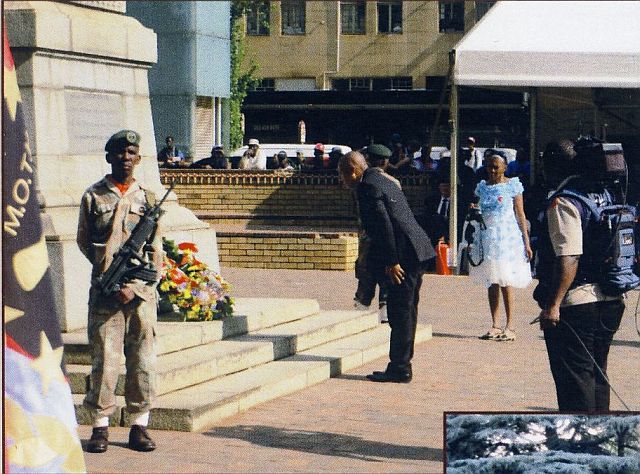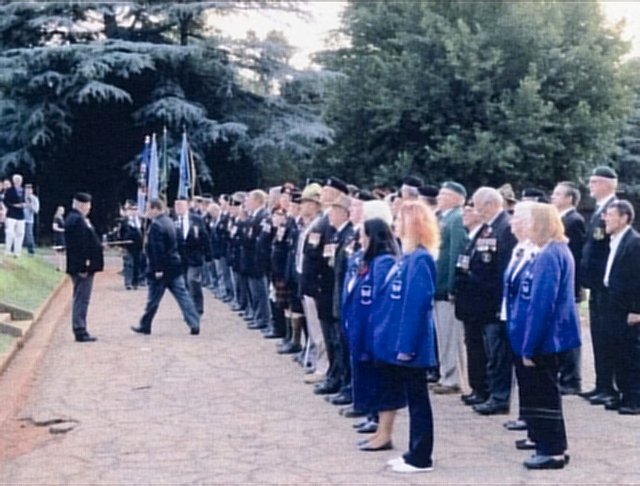

 The South African
The South African

The Mayoral Party arrives at the Cenotaph.
Remembrance Day is observed every year on 11 November. This year is particularly significant in that we commemorate the centenary of the end of the First World War (1914-1918). As the Ditsong National Museum of Military History is regarded as a memorial in part to the ultimate sacrifice made by South Africans in conflict, Remembrance Day is often considered the most important day in the Museum's calendar.
The First World War (1914-1918) was the largest man-made global catastrophe known until that time. The total number of casualties suffered during the war is estimated at around 40 million, which includes 9.7 million soldiers who were killed in action or died as a result of their wounds. Many events were organised globally to commemorate the centenary, including in South Africa, where events both large and small took place at various centres. On Sunday, 11 November 2018, the Museum took part in the Annual National Civic Remembrance Commemoration and Wreath-Laying Event at the Cenotaph in Beyers Naude Square in Johannesburg, while the Annual Memorable Order of Tin Hats (MOTH) Shadow Parade was held at the Museum later in the day.
The Armistice, 11 November 1918
In November 1918 the Germans still controlled a large part of the area of Belgium and France that they had occupied in August 1914. However, by then' the German Army had reached the limit of its endurance. It could no longer field any reserves and reports of desertions were increasing every day. Britain and France were also exhausted from four years of attrition and stalemate on the Western Front. Both armies had witnessed many planned offensives end in disaster. Yet, despite their weariness, they were buoyed by the flow of fresh United States troops across the Atlantic into France. These soldiers were well equipped and not scarred by four years of slaughter on the Western Front. Victory, therefore, seemed certain for the Allies.
Aware that defeat could no longer be avoided, the German Government opened negotiations with President Woodrow Wilson of the United States on the basis of his Fourteen Points (his statement for world peace). Prince Max of Baden, the liberal cousin of Kaiser Wilhelm II of Germany, was appointed Chancellor of Germany and given the authority to accept the Allied conditions for an armistice. Eventually, on 8 November 1918, after a series of messages had been despatched across Europe and the Atlantic., Wilson notified Prince Max that the terms of a possible armistice would be presented to his delegation by Marshal Ferdinand Foch, the Allied Supreme Commander.
Kaiser Wilhelm II abdicated the German Imperial throne on 7 November and agreed to go into exile in the Netherlands. That same day, a German delegation, led by Secretary of State Matthias Erzberger, sent a message to Foch requesting that he name a meeting place where discussions could take place. The site chosen was the Rethondes Clearing in the Forest of Compiegne.
The Allies were determined to ensure that Germany could no longer continue fighting after the conclusion of the armistice period. The terms therefore included the liberation of all German-occupied territory in France and Belgium, including AlsaceLorraine; the return of all refugees to their country of origin; the surrender by Germany of 2 500 heavy guns, 2 500 field guns, 25 000 machine guns, 3 000 trench mortars, and 1 700 aircraft; the Allied occupation of the left bank of the Rhine; and the evacuation by the German Army of the right bank.
These conditions left Germany so defenceless that she would have to agree to any Allied demands at the anticipated peace conference. After several hours of negotiations, including time for the conditions to be communicated to Berlin, the armistice was signed at 05: 10 on 11 November. It was agreed that hostilities would cease at the eleventh hour of the eleventh day of the eleventh month. The duration of the armistice was fixed at 36 hours, renewable.
The First South African Brigade on Armistice Day
The 1st South African Brigade had served on the Western Front since April 1916. By November 1918 it had come under the command of the British 66th Division. On 10 November, it was part of a mobile column, and set out along the Beaumont Road from Solre-LeChateau, with the 1 st South African Infantry Regiment in the lead. At 09:30 the column came into contact with substantial German forces located on the high ground around Grandrieu. The Germans proceeded to flood the Thure River which halted the South African advance. Patrols were posted that evening as a precaution against any attempt by the Germans to retreat under the cover of darkness. By dawn the following day the situation remained much the same. The respite had, however, provided the British Engineers with enough time to rebuild the bridge over the river at Hestrud.
The morning of 11 November was cold and foggy. The 1st SA Infantry Regiment carried out an attack on the German position but achieved little. At 10:00 Tanner received the communication that an armistice had been signed and would come into effect at 11 :00. The news apparently reached the Germans around the same time as their bombardment increased with the resolve to use up as much ammunition as possible before the fighting ceased.
At 11 :00 the firing stopped and an eerie silence followed. The only noise was the wind blowing down the lines. Eventually, one could hear the sound of cheering voices. At the end of hostilities, the line reached by the South Africans was the most eastern point gained by any troops of the British Expeditionary Force on the Western Front.
The Centenary Commemorations in Johannesburg
The commemorative service held at the Cenotaph on the afternoon of 11 November 2018 conformed to the traditional Remembrance Service and it included the Two-Minute Silence originally proposed by Sir Percy Fitzpatrick, well-known South African philanthropist, author and politician. To commemorate the 1918 armistice which had brought an end to the First World War, he had successfully appealed to King George V for a two-minutes' pause to be observed annually throughout the British Empire at the eleventh hour of the eleventh day of the eleventh month: one minute in remembrance of the fallen in war; and one minute in gratitude for those who survived.

The Mayor of Johannesburg, Clr Herman Mashaba, lays a wreath
during the ceremony at the Cenotaph on 11 November 2018.
His Worship, the Executive Mayor of the City of Johannesburg, Clr Herman Mashaba, who is also Patron-in-Chief for the annual event, presided over the commemoration event, and the sermon and scripture reading were delivered by the Reverend J Slade. The marching column included many veterans' and civic groups, such as the MOTHs, the South African Legion, regimental associations, Boy Scouts, St Johns Ambulance, the Johannesburg Emergency Services and schools. They were accompanied by the bands of the South African Police Service, the Johannesburg Metropolitan Police Department and the South African Irish Pipes and Drums. The Military Ceremonial Company was made up of members of 21 Battalion; the South African Army Band and the Choir of the Johannesburg Metropolitan Police Department provided the musical compliment.
The hymn sung during the service was the award-winning SANDF Unity Hymn, written by Chaplin I Bernhardi for the occasion of the fifth anniversary of the formation of the South African National Defence Force, sung to the tune of Amazing Grace. During the wreath-laying, many political, military and civic personalities laid wreaths on behalf of their various government departments, arms of service, military units and organisations. Mr Benjamin Daniels, a member of the Council of Ditsong Museums of South Africa, laid a wreath on behalf of the Institution. In all, an estimated 500 people attended the event.

The MOTH Shadow Parade at the Anglo-Boer War Memorial in Saxonwold, Johannesburg.
A second event took place later, in the early evening, at Ditsong National Museum of Military History, where the MOTHS, along with members of the MOTHWA and the Military Associations of Gauteng held a parade in front of the AngloBoer War Memorial adjacent to the Museum. Many members of the public also attended and were thrilled by the sights and sounds of the Regimental Pipes and Drums of the South African Irish. The parade took the form of a solemn commemoration service held at sun down.
Conclusion
The importance of remembering the end of the First World War cannot be overstated. A total of 245 419 South Africans of all races volunteered for military service during the First World War. There were 12452 South African casualties during the four years of fighting. The number of South African dead commemorated around the world by the Commonwealth War Graves Commission is 9 445. Most of them lie in cemeteries throughout Africa, the Middle East and Europe. Events such as these serve to remember all those who did not return home one hundred years ago.
References
Thoumin, R The First World War (London, Secker & Warburg, 1963).
Return to Journal Index OR Society's Home page
South African Military History Society / scribe@samilitaryhistory.org